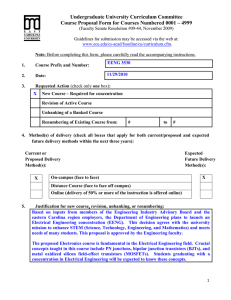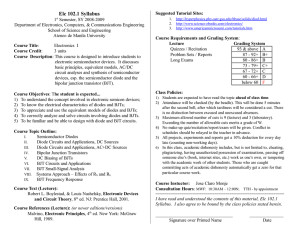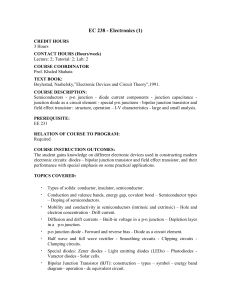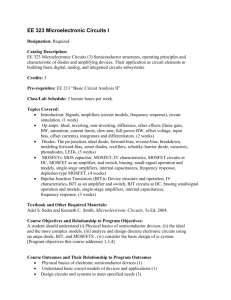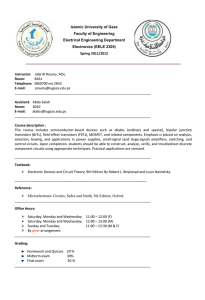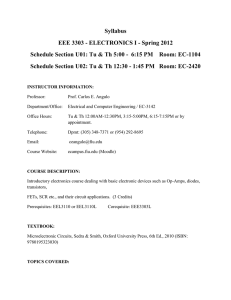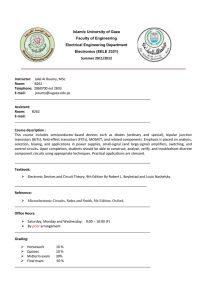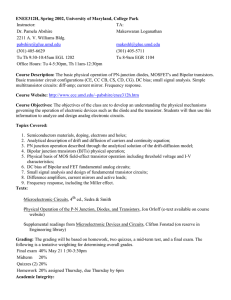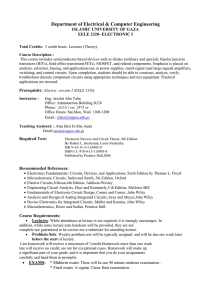3530 - East Carolina University
advertisement
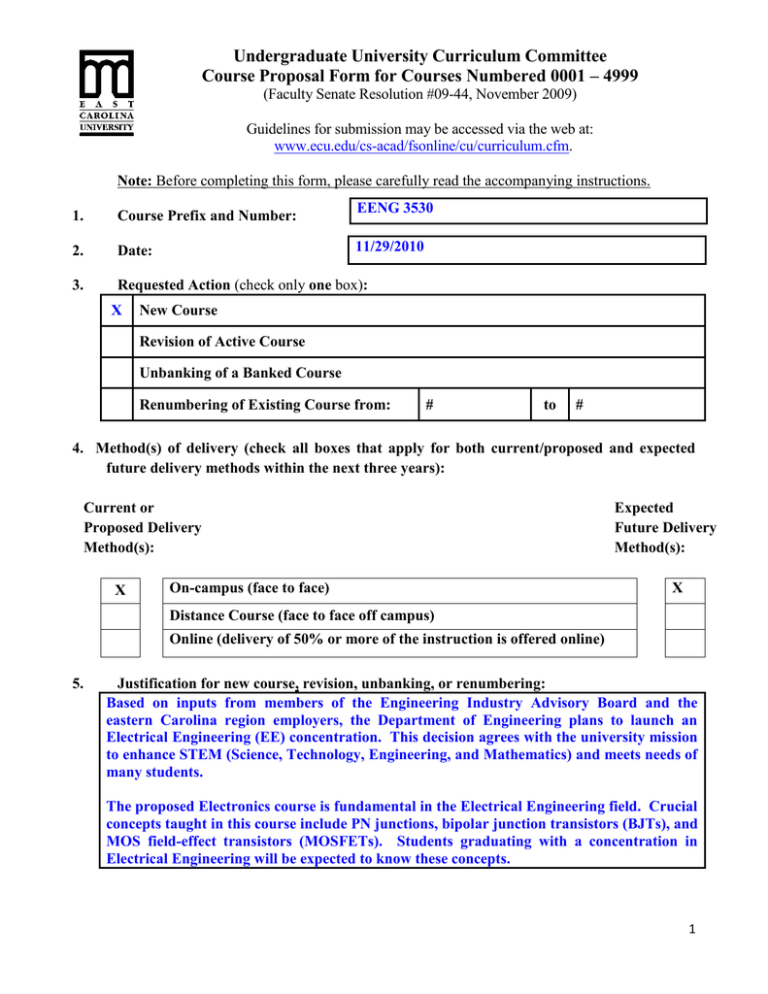
Undergraduate University Curriculum Committee Course Proposal Form for Courses Numbered 0001 – 4999 (Faculty Senate Resolution #09-44, November 2009) Guidelines for submission may be accessed via the web at: www.ecu.edu/cs-acad/fsonline/cu/curriculum.cfm. Note: Before completing this form, please carefully read the accompanying instructions. 1. Course Prefix and Number: EENG 3530 2. Date: 11/29/2010 3. Requested Action (check only one box): X New Course Revision of Active Course Unbanking of a Banked Course Renumbering of Existing Course from: # to # 4. Method(s) of delivery (check all boxes that apply for both current/proposed and expected future delivery methods within the next three years): Current or Proposed Delivery Method(s): X On-campus (face to face) Expected Future Delivery Method(s): X Distance Course (face to face off campus) Online (delivery of 50% or more of the instruction is offered online) 5. Justification for new course, revision, unbanking, or renumbering: Based on inputs from members of the Engineering Industry Advisory Board and the eastern Carolina region employers, the Department of Engineering plans to launch an Electrical Engineering (EE) concentration. This decision agrees with the university mission to enhance STEM (Science, Technology, Engineering, and Mathematics) and meets needs of many students. The proposed Electronics course is fundamental in the Electrical Engineering field. Crucial concepts taught in this course include PN junctions, bipolar junction transistors (BJTs), and MOS field-effect transistors (MOSFETs). Students graduating with a concentration in Electrical Engineering will be expected to know these concepts. 1 6. Course description exactly as it should appear in the next catalog: 3530. Electronics (3) 3 lecture hours per week. P: ENGR 2514. Fundamentals of operational amplifiers and common topologies; PN junctions, semiconductor physics, the ideal diode, and real diodes; bipolar junction transistors (BJTS) and MOS field-effect transistors (MOSFETs): physical structures, signal models, common configurations, and second-order effects. 7. If this is a course revision, briefly describe the requested change: NA NA 8. Page number from current PDF undergraduate catalog: 9. If writing intensive (WI) credit is requested, the Writing Across the Curriculum Committee must approve WI credit prior to consideration by the UCC. No Has this course been approved for WI credit (yes/no)? If Yes, will all sections be WI (yes/no)? 10. If service-learning (SL) credit is requested, the Service-Learning Advisory Committee must approve SL credit prior to consideration by the UCC. No Has this course been approved for SL credit (yes/no)? If Yes, will all sections be SL (yes/no)? 11. If foundations curriculum (FC) credit is requested, the Academic Standards Committee (ASC) must approve FC credit prior to consideration by the UCC. If FC credit has been approved by the ASC, then check the appropriate box (check at most one): 12. English (EN) Science (SC) Humanities (HU) Social Science (SO) Fine Arts (FA) Mathematics (MA) Health (HL) Exercise (EX) Course Credit: 3 = Credit Hours 3 Weekly or Per Term Lab Weekly or Per Term = Credit Hours s.h. Studio Weekly or Per Term = Credit Hours s.h. Practicum Weekly or Per Term = Credit Hours s.h. Lecture Hours s.h. 2 Internship Weekly Per Term or = Credit Hours s.h. s.h. Other (e.g., independent study): Total Credit Hours Anticipated yearly student enrollment: 14. Affected Degrees or Academic Programs: 15. s.h. 30 13. Degree(s)/Course(s) BS Engineering 3 PDF Catalog Page Change in Degree Hours 298 None Overlapping or Duplication with Affected Units or Programs: X Not Applicable Applicable (Notification and/or Response from Units Attached) 16. Approval by the Council for Teacher Education (required for courses affecting teacher education programs): X Not Applicable Applicable (CTE has given their approval) 17. Instructional Format: please identify the appropriate instructional format(s): X Lecture Technology-mediated Lab Seminar Studio Clinical Practicum Colloquium Internship Other (describe below): Student Teaching 18. Statements of Support: (Please attach a memorandum, signed by the unit administrator, which addresses the budgetary and staff impact of this proposal.) Current staff is adequate X Additional staff is needed (describe needs below): As part of the current strategic plan for the program, we anticipate continued growth in student enrollment to near 700 majors by 20153 2016 and approximately 32 faculty from our current base of 20. This course is within the proposed electrical engineering concentration. Offering all of the courses within the electrical engineering concentration will require one equivalent faculty member out of the planned increase. Current facilities are adequate Additional facilities are needed (describe needs below): This course is within the proposed X electrical engineering concentration. Our laboratory facilities, which already support classes for circuits, controls, bio processing and biomedical instrumentation, are capable with minor additional investment (less than $45,000 during 2011- 2013) to support this concentration. X Initial library resources are adequate Initial resources are needed (give a brief explanation and estimate for cost of acquisition of required resources below): X Unit computer resources are adequate Additional unit computer resources are needed (give a brief explanation and an estimate for the cost of acquisition below): X ITCS Resources are not needed Following ITCS resources are needed (put a check beside each need): Mainframe computer system Statistical services Network connections Computer lab for students Describe any computer or networking requirements of this program that are not currently fully supported for existing programs (Includes use of classroom, laboratory, or other facilities that are not currently used in the capacity being requested). Approval from the Director of ITCS attached 19. Syllabus – please insert course syllabus below. Do not submit course syllabus as a separate file. You must include (a) the name of the textbook chosen for the course, (b) the course objectives, (c) the course content outline, and (d) the course assignments and grading plan. Do not include instructor- or semester-specific information in the syllabus. East Carolina University – Department of Engineering – Course Syllabus 4 EENG 3530: Electronics Required Materials: A.S. Sedra and K.C. Smith, Microelectronic Circuits. 5th Ed. Oxford University Press, 2007 (ISBN: 0195338839) Course Objectives: Upon completion of this course, students shall be able to: Describe the basic characteristics of ideal operational amplifiers (op amps) Perform basic circuit analysis on passive op amp circuits Describe the physics of a PN junction Describe the operation of an ideal diode and understand its I-V characteristics Design basic circuits involving diodes, including rectifiers, zener diode regulators, and LED circuits. Describe the physics and theory of operation of a bipolar junction transistor (BJT) and MOS field-effect transistor (MOSFET) Utilize external components to design transistor bias circuitry Utilize common transistor models to perform small- and large-signal analysis Utilize common single-transistor configurations to design basic amplifier circuits Design basic circuits using transistors as switches Describe parasitic transistor capacitances and understand their effect on a signal Design basic digital logic gates using CMOS Implement and simulate a transistor-based circuit in SPICE Course Topics: Topics covered in this course include: Lecture hour 1 2 3 4 5 6 7 8 9 10 11 12 13 14 15 16 17 18 19 20 21 Topic Course Introduction and op amp review Op amp review and modeling Amplifier frequency response and digital logic inverters Physics of the PN junction Ideal diodes Diode circuits and diode modeling Zener diodes, rectifiers, and regulators Schottky diodes, photodiodes, and LEDs Intro to bipolar junction transistors (BJTs) Intro to BJTs Intro to BJTs Small signal models of the BJT Graphical BJT analysis Biasing the BJT for discrete-circuit operation Basic single-stage BJT amplifiers The transistor as a switch and large signal model Second order BJT effects Introduction to MOSFETS Introduction to MOSFETS MOSFET I-V characteristics The MOSFET amplifier 5 22 23 24 25 26 MOSFET biasing Basic single-stage MOSFET amplifiers and Seconds order BJT effects The MOSFET as an analog switch CMOS digital logic gates Grading Policy and Assignments Students will be evaluated based on the combination of class activities. The final grade will be assessed with the following criteria: A B C D F Grading 90% or better 80% or better 70% or better 60% or better Less than 60% Assessment Homework Assignments Course Project Laboratory Projects Tests Final Exam Total 20% 15% 20% 30% 15% 100% 6
